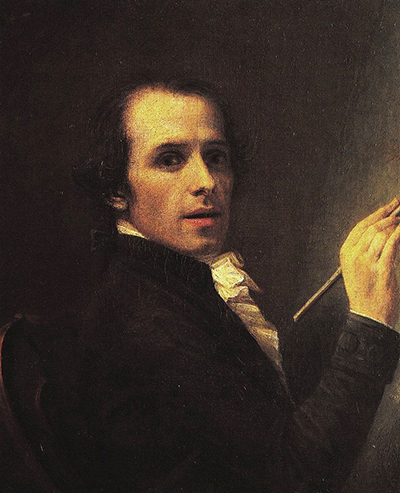This delightful painting from 1792 allows us to understand more about how the artist saw himself. Canova pictures himself at work, in a descriptive manner that was common during art from past centuries. Many figures would display their own occupations within the content of each piece.
Canova looks cheerful within this portrait, perhaps enjoying working in an art form that was never considered his specialisation. He can be described as an occasional painter, leaving behind a relatively contribution in oils, as compared to his preference for marble sculptures which was the key to him establishing himself as a major Italian artist who courted patrons from his home nation as well as abroad, such as France and Austria. This self portrait allows us to appreciate the high level of training that he clearly received in the art of oil painting, as he envelops his image in bright light, with most focusing on his facial features as well as his hand which holds a symbolic paintbrush. The background behind him is left entirely devoid of detail, allowing the full focus to be given to his own image, which appears positive and youthful. He would also complete a self portrait sculpture, though elements of it may have been finished off by members of his studio.
This is a very welcoming portrait, in which the artist welcomes us into his work. He looks dashing as compared to later portraits in which he ages visibly, with many other artists completing portraits of this respected artist in the years that followed afterwards. Others would complete drawings of some of his sculptures and sometimes turn these into prints which could then be distributed across Europe for relatively nominal prices. Canova himself was able to supplement his income by producing several different versions of his sculptures which then allowed him to satisfy multiple patrons, though we do not think he did the same with his paintings which are most likely to have always remained unique items. His drawings would provide the basis to many of his sculptures, and they would often be the starting point to many of his larger projects, as an easy way to try out new ideas.
It was common for artists to work within different mediums in past art movements, and most famous for this were the likes of Michelangelo and Da Vinci who became regarded as Renaissance Men because of their ability to work at a very high technical level across a diverse array of disciplines. One remembers Da Vinci's inventions, for example, whilst Michelangelo would impress in all of painting, sculpture and architecture. The likes of Canova could not quite reach those heights, though, and wanted more to see these alternative forms as a means to rest, relax and experiment without the pressure of their use of sculpture. In today's world we find a new route being taken by many, named mixed media, where people work within a single discipline but vary and combine the use of different materials together.




